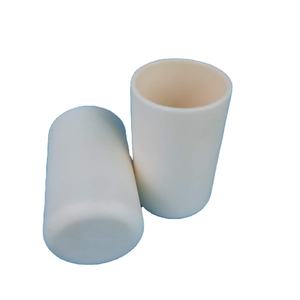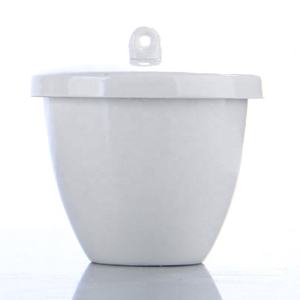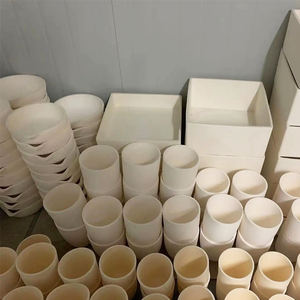Professional industry ceramic supplier, silicon nitride, silicon carbide, aluminum nitride and any other kinds of ceramics.
PRODUCT PARAMETERS
Description
Overview of Lab Melting Used Fused Silica Quartz Sio2 Ceramic Crucible
Lab Melting Used Fused Silica Quartz Sio2 Ceramic Crucible are specialized containers designed for withstanding extremely high temperatures in laboratory and industrial settings. They are essential for processes such as melting, calcining, and heat-treating a wide variety of materials, including metals, glasses, and chemicals. Our crucibles are engineered for superior thermal stability and chemical resistance, ensuring purity and reliability in the most demanding applications.
Features of Lab Melting Used Fused Silica Quartz Sio2 Ceramic Crucible
-
Exceptional Thermal Shock Resistance: Withstands rapid temperature changes without cracking, ensuring durability and a long service life.
-
High-Temperature Stability: Maintains structural integrity at extreme temperatures, often exceeding 1500°C.
-
Excellent Chemical Inertness: Resists corrosion and reaction with molten metals, acids, and aggressive chemical fluxes.
-
High Purity & Low Contamination: Manufactured from premium materials to prevent sample contamination during sensitive processes.
-
Optimized Thermal Properties: Designed for efficient heat transfer and consistent performance in furnace environments.
-
Robust Mechanical Strength: Offers good resistance to physical impact and abrasion during handling and use.
Specifications of Lab Melting Used Fused Silica Quartz Sio2 Ceramic Crucible
Fused silica quartz crucibles are essential tools for laboratory melting. They are made from pure silicon dioxide. This material is excellent for high-temperature work. Fused silica quartz offers outstanding purity. Crucibles made from it have very low levels of impurities. This is crucial for preventing contamination. Contamination can ruin sensitive experiments or samples. These crucibles withstand extremely high temperatures. They can handle heat over 1700 degrees Celsius. This makes them suitable for melting many materials. Fused silica quartz handles sudden temperature changes well. This thermal shock resistance is a key advantage. Lab processes often involve rapid heating or cooling. The crucible must cope with this stress. Chemical resistance is another important feature. These crucibles resist attack from many acids. They also resist attack from molten salts. They are generally safe for common lab chemicals. Their surface is smooth. This smoothness prevents materials from sticking. Easy sample removal is important. Cleanup is simpler too. These crucibles come in various sizes. Common sizes range from small 10ml capacities to larger 100ml sizes. Different shapes are available too. Standard shapes include tall form and low form. The right size and shape depend on the application. Fused silica quartz is transparent. You can see the contents inside. Monitoring the melting process is easier. This transparency helps with visual checks. They are reusable if handled carefully. Proper cleaning extends their lifespan. Handle them gently to avoid cracks. Avoid sharp impacts. Fused silica quartz crucibles are ideal for precious metals. They work well for high-purity glass work. They are used in semiconductor research. They are common in analytical chemistry labs. Their reliability makes them a lab favorite.
Applications of Lab Melting Used Fused Silica Quartz Sio2 Ceramic Crucible
Fused silica quartz crucibles are important tools in labs. They handle high temperatures well. This makes them good for melting things. These crucibles are made from very pure silicon dioxide. This purity matters. It means the crucible won’t add unwanted stuff to your melted material. They resist chemicals too. Acids or bases usually won’t hurt them. This is useful in many experiments.
People use these crucibles for melting metals. They are common in labs studying alloys. You can melt different metals together in them. The crucible stays stable. It doesn’t react with the molten metal. This keeps your sample pure. Glass workers also use them. You can melt glass frit or batches inside. The silica crucible can take the heat needed for glass. It doesn’t contaminate the glass melt.
Chemical analysis needs these crucibles sometimes. You might need to fuse a sample. This prepares it for testing. The silica crucible holds the sample safely at high heat. It doesn’t add elements that could mess up your results. Researchers use them for high-temperature reactions. Some reactions need extreme heat. The crucible provides a stable container. It handles the thermal stress.
These crucibles work well in induction furnaces. They also work in resistance furnaces or kilns. They heat up evenly. They cool down without cracking easily. Their high purity is key. It prevents unwanted reactions. This is vital for getting accurate results. You see them in university labs. Industry labs use them too. They are reliable for demanding melting jobs.
Company Profile
Tanki New Materials Co.Ltd. focus on the research and development, production and sales of ceramic products, serving the electronics, ceramics, chemical and other industries. Since its establishment in 2015, the company has been committed to providing customers with the best products and services, and has become a leader in the industry through continuous technological innovation and strict quality management.
Our products includes but not limited to Aerogel, Aluminum Nitride, Aluminum Oxide, Boron Carbide, Boron Nitride, Ceramic Crucible, Ceramic Fiber, Quartz Product, Refractory Material, Silicon Carbide, Silicon Nitride, ect. please feel free to contact us.

Payment Methods
T/T, Western Union, Paypal, Credit Card etc.
Shipment Methods
By air, by sea, by express, as customers request.
5 FAQs of Lab Melting Used Fused Silica Quartz Sio2 Ceramic Crucible
Here are 5 FAQs about Lab Melting Used Fused Silica Quartz (SiO2) Ceramic Crucible:
1. What exactly is a fused silica quartz crucible?
It’s a container made for melting stuff in labs. It’s crafted from pure silica sand melted at super high heat. This process makes a solid, glass-like material. People call it fused quartz or fused silica. It’s different from regular ceramics.
2. Why use fused silica crucibles for high temperatures?
They handle very high heat extremely well. These crucibles don’t melt easily themselves. They also resist sudden temperature changes better than many other materials. This means less chance of cracking when heating up or cooling down fast. They are stable and won’t react with most materials you melt.
3. How careful do I need to be handling them?
You need to be very careful. Fused silica is strong against heat but it’s brittle. It can chip or crack if knocked hard or dropped. Avoid squeezing it tightly. Don’t put it directly on cold surfaces when hot. Let it cool slowly after use.
4. How do I clean a used fused silica crucible?
Cleaning depends on what was melted. First, let the crucible cool completely. For many residues, soaking in a strong acid like hydrofluoric acid works. But be extremely careful with that acid. It’s very dangerous. Sometimes gentle scrubbing with water or a weak acid helps. Avoid harsh abrasives. They can scratch the surface.
5. When should I replace a fused silica crucible?
Replace it if you see cracks, deep scratches, or chips. These flaws make it weak. It could break during the next heating cycle. Also replace it if the surface looks cloudy or etched deeply. This might mean the material is degrading. Even small defects can lead to failure under heat stress.
REQUEST A QUOTE
RELATED PRODUCTS

High-hardness Calcium-stabilized High-purity Zirconia Ceramic Crucible for Melting Metals

Alumina Ceramic Aluminum Oxide Crucible for Laboratory

Customized Longer Service Life Silicon Nitride Ceramic Crucible for Melting Aluminum and Alloys

Laboratory High Temperature Ceramic Oven Dental Ceramic Crucible

High Purity Alumina Ceramic Crucible Melting Crucible



